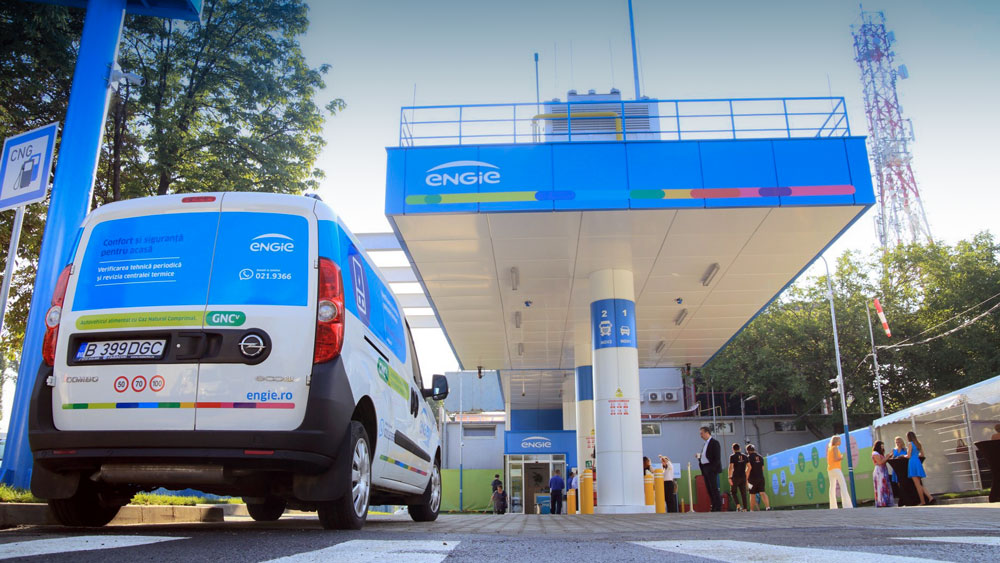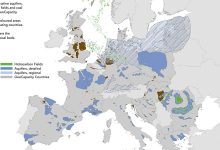CNG Fuelling Stations Increasingly Attractive
The use of Compressed Natural Gas (CNG) as alternative fuel for increasing energy efficiency seems to be a winning card. In conditions in which energy resources are increasingly expensive, CNG could efficiently offset the situation and this is why in Romania the number of stations opened is ever-increasing.
Compressed Natural Gas (CNG), consisting mainly of methane [CH4], is a substitute of fossil fuels, such as gasoline, diesel or propane/LPG, being obtained by compressing natural gas at a pressure of 200-248 bar, at less than 1% of the volume it occupies at the standard atmospheric pressure.
Increasingly more cities invest in local transport fleets on CNG
According to a study conducted by Oana Gulei-Gradinaru (NGVA Romania), the objectives of purchasing non-polluting buses will go up from 24% to 45% in 2025 and from 33% to 66% in 2030, depending on the population and GDP of each country. Romania and other countries with lower GDP will have a gradual development, of approximately one fifth of the new bus fleet in public transport and should reach zero emissions in 2030. The initial target must be reached within approximately two years of the entry into force of the Directive, which could materialize in Q3/Q4 2021 (by December 31, 2025).
Why CNG?
- Because natural gas is an abundant resource.
- Because it is a solution proven at global level.
- Because it is: ECOLOGICAL – is the least polluting of the fossil fuels; ECONOMIC – its cost is lower; SILENT – noise pollution of CNG engines is lower than in conventional heat engines; SAFE – safety in operation is practically proven.
One of the main advantages, from the point of view of society, consists of reducing greenhouse gas (GHG) emissions compared to the other fossil fuels, and correspondingly consists of reducing effects on climate change. The estimated reduction of CO2 emissions compared to gasoline and diesel is between 13% and 26% (ngvamerica.org), and considering the most relevant GHG emissions generating effects on climate changes (CO2, CH4, N2O), their reduction is estimated at 29%-39%. At the same time, replacing traditional fuels reduces air pollution and improves population health.
The main harmful emissions (NOx – nitrogen oxides, SO2 – sulphur dioxide, non-methane volatile organic compounds and particulate matter – PM10 and PM2.5) are lower in the case of CNG combustion compared to other fossil fuels.
CNG is used on internal combustion engine vehicles that have been ‘converted’ (later equipped with a CNG facility) or on vehicles that have been manufactured especially for CNG, either individually or with a segregated gasoline system to extend the range (dual fuel) or in combination with other fuel, such as diesel (biofuel). The context is favourable to CNG, as diesel price is in continuous growth and pollution puts increasing pressure at international level.
In developing countries, such as Romania, the decision to install a dual fuel system is rather economic than related to social responsibility. Consumers in these countries are rather interested in purchasing a new car than reducing the costs of vehicles they already own. Therefore, converting the existing vehicles to CNG, especially among fleets or taxis, can significantly reduce pollution at national level and help reach the European targets.
Reduction of carbon emissions, absolute priority of Europe
Energy efficiency means the ratio of output of performance, service, goods or energy, to input of energy (Directive 2012/27/EU). According to Law No. 121/2014 on energy efficiency, improving energy efficiency is a strategic objective of the national energy policy, due to major contribution it has in achieving the security of energy supply, sustainable development and competitiveness, in saving the primary energy resources and reducing greenhouse gas emissions. One of the main concerns of policy makers at European Union level, according to the Kyoto Protocol, also strengthened by the Paris Agreement, is related to the reduction of greenhouse gas emissions, corresponding to the assumed targets – a 20% reduction of these emissions for period 2013-2020.
Under Romanian Presidency in the first six months of this year, the Council of the European Union reached an agreement with the European Parliament on the reform that will determine the reduction of carbon emissions in transport. The agreement was approved by the member states of the European Union within the EU Council. As such, Member States will have 24 months, from the moment of entry into force of the European Directive, for the implementation at national level of decisions on ensuring a cleaner environment by using clean vehicles. The main objectives are to purchase some vehicles, trucks, buses as clean as possible between 2025 and 2030. These new rules will also apply to public road transport services, special passenger transport services, waste collection, postal and parcel services.
According to a communique of the environmental group Transport & Environment, the agreement on reducing carbon emissions on February 12, 2019 has two different implementation terms for Eastern and Western Europe, with Eastern European countries having lower targets than Western ones.
Case study (data provided by TDR Energy)
We consider a gasoline car, with an average consumption of 7.0 litres/100 km. By converting gasoline to CNG, the average fuel consumption becomes 4.3 kg/100 km. CO2 emissions resulting from gasoline consumption are:
CO2 emissions (G) = Gasoline quantity x EF where: EF = Emission Factor
CO2 emissions (G) = 7 l x 2.79972 Kg CO2 e/l = 19.59804 Kg CO2e reported per 100 km travelled and results in a consumption of 195.9804 g CO2 e/km
CO2 emissions resulting from CNG consumption:
CO2 emissions (CNG) = CNG quantity x EF where: EF = Emission Factor
CO2 emissions (CNG) = 4.3 kg x 3298.43 Kg CO2 e/ton = 13.19372 Kg CO2e reported per 100 km travelled and results in a consumption of 131.9372 g CO2 e/km
The emission factors used are approved at the European Commission level through the Joint Research Centre and take into account the life cycle of fuel, taking into account the Heat Power and WTT (Well to Tank). This results in a reduction in GHG emissions by 32.7% when using compressed natural gas – CNG – as a fuel compared to gasoline.
Increasingly more CNG stations in Romania
CNG Romania aims to implement the first network of fuelling stations for compressed natural gas vehicles in Romania along the European transport corridors. The coordinator of the project is Denisson Energy (Antares Group), having NGVA Romania as partner. The allocated budget amounts to EUR 5.2 million, with 85% co-financing from the European Union under the CEF Program. The project, whose duration of implementation is March 2016 – December 31, 2020, is supervised by INEA – the Innovation and Networks Executive Agency (European Commission) and the Ministry of Transport (Romania).
The general objective of the project is support for implementing a sustainable and efficient transport system, decarbonization of road transport in the Pan European corridors, by introducing the alternative CNG fuel in Romania. The specific objective is to build nine CNG fuelling stations along the road corridors of the TEN-T network in Romania, in order to cover the potential of long-distance transport and urban transport; support for market entry and use of CNG in Romania.
So far, stations have been opened in Ramnicu Valcea (CNG Romania – Antares Natural Gas), Bucharest (by Engie), Pantelimon (CNG Logistic Group and Flora Gas), Buzau (LPG & CNG Service Solutions), Mihailesti (INA Garden), the closest across borders being that in Ruse, Bulgaria. And the process will definitely continue.
CNG, huge importance for both trucks and buses
Volkswagen Group and its industry partners from the gas supply, network, and filling station operation sectors showcased their products and services at the 3rd CNG Mobility Days in Berlin (25-26 June 2019), presenting an overview of the current situation and the future of CNG. Volkswagen Group brands also exhibited their latest CNG models in the passenger car, truck and bus segments.
In parallel with the advancing electrification of its fleet, Volkswagen Group and its brands continue to rely on CNG as an alternative drive technology for decarbonizing road transport, and the product range has been revised and expanded again with this in mind. Volkswagen Group currently offers the widest selection of CNG vehicles of any manufacturer, by a substantial margin. At the annual general meeting in mid-May 2019, Herbert Diess, Chairman of the Board of Management of Volkswagen, announced that CNG would continue to play an important role for the group in the future: “We are the global market leader for gas drive systems, and better positioned than our competitors. We also plan to continue further expanding and improving this technology.”
Using CNG as an energy source for automobiles meaningfully contributes to reducing emissions, as well as representing a cost-efficient customer alternative to petrol and diesel.
“Volkswagen is committed to the Paris Climate Agreement. CNG has an important role to play in the alternative drive systems strategy that runs alongside the Group’s electrification offensive. It is sufficiently proven, immediately available, efficient and cost-effective. Furthermore, CNG cars are not affected by driving bans in city centres,” explains Stephen Neumann, Volkswagen Group Representative for CNG Mobility.
For the first time, the MAN and SCANIA brands also reported on the latest developments for trucks and buses, as part of the CNG Mobility Days. According to the new emissions standards in the European Union, by 2030 CO2 emissions must fall 30% from 2019 levels – a goal that is virtually unattainable using conventional drive types. CNG, which already has 15% lower fuel consumption than diesel vehicles, is an immediately available and usable alternative for trucks and buses. At present, a particularly persuasive argument in favour of using CNG – especially for haulage companies – is the exemption from tolls for natural gas-powered trucks.







